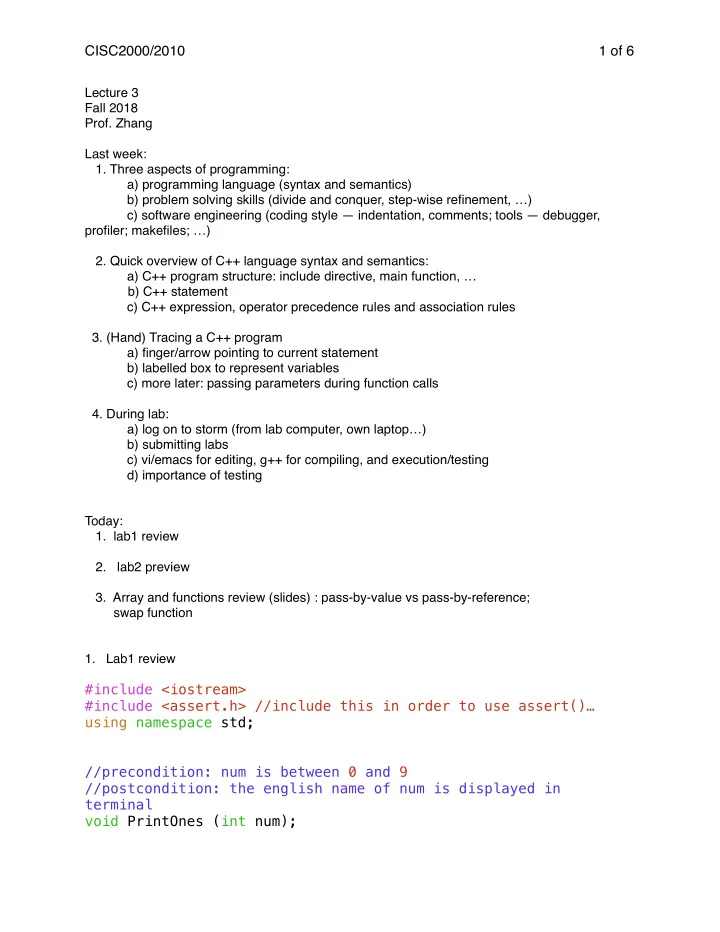

CISC2000/2010 � of � 1 6 Lecture 3 Fall 2018 Prof. Zhang Last week: 1. Three aspects of programming: a) programming language (syntax and semantics) b) problem solving skills (divide and conquer, step-wise refinement, …) c) software engineering (coding style — indentation, comments; tools — debugger, profiler; makefiles; …) 2. Quick overview of C++ language syntax and semantics: a) C++ program structure: include directive, main function, … b) C++ statement c) C++ expression, operator precedence rules and association rules 3. (Hand) Tracing a C++ program a) finger/arrow pointing to current statement b) labelled box to represent variables c) more later: passing parameters during function calls 4. During lab: a) log on to storm (from lab computer, own laptop…) b) submitting labs c) vi/emacs for editing, g++ for compiling, and execution/testing d) importance of testing Today: 1. lab1 review 2. lab2 preview 3. Array and functions review (slides) : pass-by-value vs pass-by-reference; swap function 1. Lab1 review #include <iostream> #include <assert.h> //include this in order to use assert()… using namespace std; //precondition: num is between 0 and 9 //postcondition: the english name of num is displayed in terminal void PrintOnes (int num);
CISC2000/2010 � of � 2 6 //precondition: num is between 11 and 19 //postcondition: the english name of num is displayed in terminal void PrintTeen (int num); //precondition: num is 10, 20, ..., and 90 //postcondition: the english name of num is displayed in terminal void PrintTens (int num); // precondition: num has a value between 0 and 999 // postcondition: the English name of the num is displayed in terminal (standard output) void PrintNumber (int num); int main() { int number = 0; cout << "Enter a number "; cin >> number; PrintNumber(number); return 0; } // precondition: num has a value between 0 and 999 // postcondition: the English name of the num is displayed void PrintNumber (int num) { cout <<"PrintNumber " << num << "\n \n"; assert (num<=999); //checking precondition //if the condition num<=999 is false, the whole //program aborts and display that this assertion fails // divide the numbers by relevant digits to get the relevant answers int hundred = num /100 ; int tens = //(num % 100); //Misleading Names num / 10 % 10; //set tens to the digit in //10-th place int ones = (num % 10 );
CISC2000/2010 3 � of � 6 //A check-point: making sure digits are properly extracted… cout <<“checking: hundred=“<< hundred <<“; tens=“<<tens<<“; ones=“<<ones<<endl; //Draw a flowchart about what we want to do first… //Please see the last page for the flowchart // Rewrite the rest of this function based upon the flowchart //only display hundred if it is completly divisible by 100 —- misleading comment if (hundred > 0) { PrintOnes(hundred); cout << " Hundred “; } // printing out the teens in the similar manner if ((tens > 10)&& (tens < 20)) { PrintTeen(tens); //setting tens to zero because there is no need for it anymore tens = tens - tens ; } //if it not teens than start displaying tens by minusing the ones tens = tens - ones ; if ((tens == 10)|| (tens > 19)); PrintTens (tens); if (ones > 0); { PrintOnes (ones); } cout <<endl; }
CISC2000/2010 � of � 4 6 void PrintOnes (int num) //precondition: num is between 0 and 9 //postcondition: the english name of num is displayed in terminal { string Names[10]={"Zero", "One", "Two", "Three", "Four", "Five", "Six", "Seven", "Eight", “Nine"}; cout << Names[num]; } void PrintTeen (int num) //precondition: num is between 11 and 19 //postcondition: the english name of num is displayed { //Better to use nested if statement here; or use an array // as lookup table string teensNames[9]={“Eleven”, “Twelve”, “Thirteen”, “Fourteen”, “Fifteen”, “Sixteen”, “Seventeen”, “Eighteen”, “Nineteen”}; assert (num>=11 && num<=19); cout << teensNames[num-11]; /* if (num == 11) cout << "Eleven "; if (num == 12) cout << "Twelve "; if (num == 13) cout << "Thirteen "; if (num == 14) cout << "Fourteen "; if (num == 15) cout << "Fifteen "; if (num ==16) cout << "Sixteen "; if (num ==17) cout << "Seventeen "; if(num == 18) cout << "Eighteen "; if (num ==19) cout << "Nineteen “; */ }
CISC2000/2010 � of � 5 6 void PrintTens (int num) //precondition: num is 10, 20, ..., and 90 //postcondition: the english name of num is displayed in terminal { if (num == 10) cout << "Ten "; if (num == 20) cout << "Twenty "; if (num == 30) cout << "Thirty "; if (num == 40) cout << "Fourty "; if ( num == 50) cout << "Fifty "; if ( num == 60) cout << "Sixty "; if (num == 70) cout << "Seventy "; if (num == 80) cout << "Eighty "; if (num == 90) cout << "Ninety "; } 2. Lab2 Preview: a few pointers a) Top-down approach to implement the decision tree. b) Common logic error when testing some condition as follows: two strings are same if all characters in the two string matche. i.e., two strings are not the same if some characters do not match. A number n is prime if it cannot be divided by all numbers from 2 to n-1. i.e., a number is not prime if it can be divided by one number from 2 to n-1.
CISC2000/2010 � of � 6 6
Recommend
More recommend